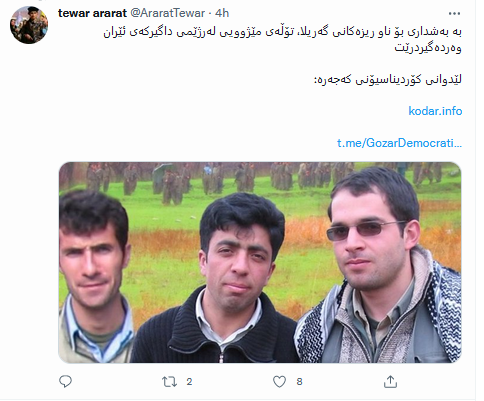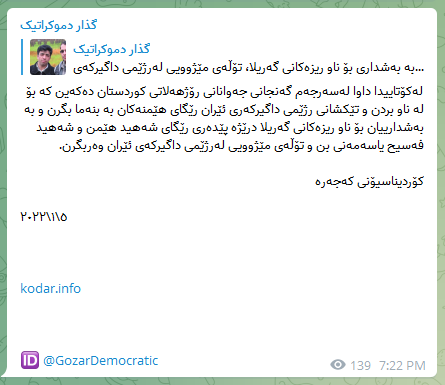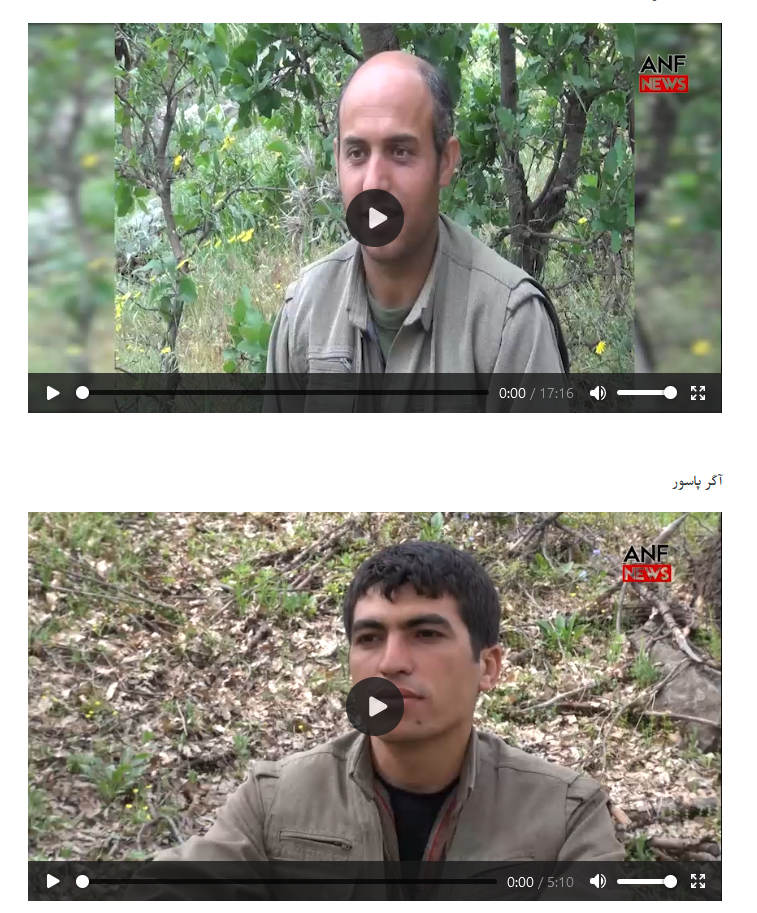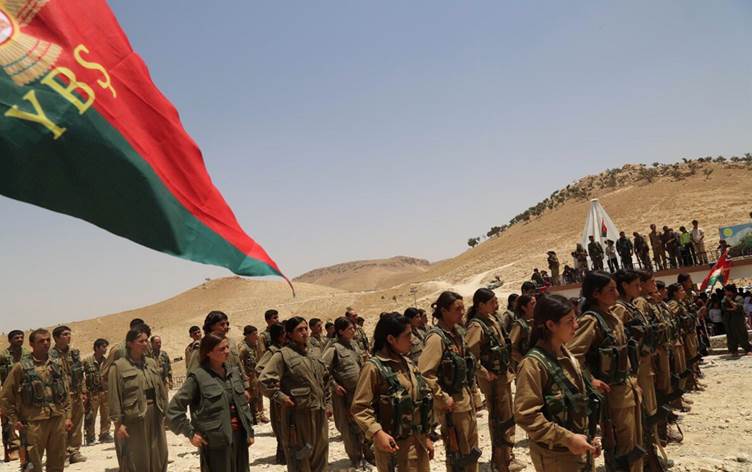This investigation explores the issue of PJAK/PKK recruitment through social media, most particularly on their Telegram channels that are set up to look like ‘news channels’, a Twitter campaign, and videos posted on sites such as YouTube and ANFpersian. This is an attempt to analyze the communication process between a well–crafted message and a vulnerable audience.
Social media is an especially effective means by which to reach a vulnerable audience, inside their homes, already isolated due to a global pandemic and difficult socioeconomic circumstances.. A better understanding of this use of social media will enhance the abilities of NGO’s in the prevention of child recruitment by this group.. By an odd or rather unfortunate coincidence of sociopolitical history and innovation in communication technology, a perfect storm of propaganda has been unleashed by the promulgation of PJAK messaging through social media glorifying the sacrifice of one’s own life for a ‘greater goal’, namely Kurdayeti (Kurdishness).
PJAK and PKK are each targeting people from a different perspective; however, the mission of both groups remains the same despite their use of different strategies. They are increasing their long–term strength by targeting youth through social media and attacking other Kurdish parties (such as KDP, PUK), and the governments it sees as their nemesis (mainly Turkey, but also Iran).
Purpose and significance
Any attempt to understand how PJAK can create messages to lure hundreds of Kurds to their cause, requires a critical analysis of the interaction between the rhetoric of the message and the psychology of the vulnerable receiver, including a profile of those drawn to PJAK and PKK.
Governments in the Middle East in general do not, of course, welcome terrorist groups. However, many of those who are influenced by the narrative of terrorist groups and inhabit these countries believe they have no other recourse. In such areas, the often uneducated people that form the target group, have no power to influence the governments of their own countries. More radical demands for change or attempts to improve the situation often land them in prison. Western powers, for the most part, have turned a blind eye to these oppressive governments with which they have done business, as for example in their insatiable appetites for carbon based fuels. On the other hand, they also close an eye to opposition groups as they obviously need them to retain the status quo – and thus their occupation – in the Middle East.
Opposition groups such as PJAK and PKK – although officially marked as terrorist organizations – have offices in Western countries, spread their propaganda freely through Europe-based TV channels, and are often glorified in Western media. The same media tend to close an eye to the less glamorous sides of these groups, such as the involvement of child soldiers, and the repeated extortion of locals to fund ‘the cause’. Locals that are exposed to an attractively packaged propaganda message, fabricated in sophisticated European propaganda factories, are easy targets.
This is because to whom PJAK appeals are not well-educated, sophisticated, or experienced adults, but teenagers and adolescents that live in the countries’ border regions, are often impoverished, and have left school early to help provide for their families, in short: those who cannot see PJAK ‘s message for what it is: propaganda.
Behind PJAK’s and ‘mother party’ PKK’s public face and domination of Kurdish news outlets and social media, there are clearly educated and well–practiced communication managers who have created a range of mediums that blend the familiar elements of a proto-typically attractive, western music video with PJAK’s proclamations of friendship, martyrdom, freedom, dancing circles, ‘sticking to one’s culture’, and the heroic pursuit of a common enemy. Young attractive women form the center pieces of these videos. Next to these videos, messages concerning the deeds of the perceived enemy are enlarged, and no other Kurdish initiatives to improve living conditions of local Kurds are showcased. PJAK is the only possible savior.
These communicative skills are put to use to create a familiar and accessible format to uproot new adherents from typically mundane, directionless lives as factory workers, farmers, shopkeepers, cross-border smugglers (kolbers) etc. to join a cause that serves a purpose ‘far greater than themselves’.
Leaving that mundane, directionless life is easy: one only needs to send the admin a message to be able to run off to the ‘mountains of freedom’. However, it is the skills of the communication managers who have led them to that conclusion. And once trapped in the mountains, far away from home, the new recruit sees no way back.
Glorifying ‘martyrs’
A study conducted by IKHRW analysts reviewed how PJAK relies on social media for recruitment, especially for its fighters that come from larger towns, which passing forces cannot enter easily. The organization needs to control their followers and maintain their allegiance while at the same time substantially increasing their numbers after loss due to death or desertion.
The organization’s members that were killed-in-action dominate its media narrative. By showing videos and pictures of the fallen member over and over again, in combination with the phrase ‘Shahid namirin’ or ‘Martyrs never die’ suggesting its fallen members become immortal (i.e. they will never be forgotten), it glorifies ‘martyrdom’ in the same way Islamic terrorist groups are known to do.
Consequently, extensive efforts at recruitment by means of the PJAK media machine play an ever more dangerous role in achieving their central objective.

For example, in this tweet we observe a photo-shopped image of three of the group’s killed members, with a link to a telegram-channel that pushes about 10 to 15 messages per day, and the text: “By joining the guerrilla ranks, you can take their revenge from the Iranian occupation regime. Click for more information.”.
In one message, the group’s media wing tries to trick the reader in to multiple actions. It lures a passing Twitter-user to a more active Telegram-channel, where it will bombard the user with propaganda multiple times per day, it glorifies the deaths of its previous recruits and plays on the emotions of those users that feel sympathy for them, and provides a way to join the organization ‘just one click away’.
Their strategy is to appeal to the emotions of their followers. It also provides steps to its followers. The follower can join the organization easily by contacting the admin of a channel, the follower is asked to share the message with his/her own followers and social contacts, and the follower is asked to join a second channel where he or she will receive an even larger amount of propaganda, which then again will lead to the follower to physically join the group, or share its messages.
Social Media and the ‘Need for affiliation’
Let’s see why Social Media is such an effective means of recruitment.
The use of social media such as Telegram, Facebook, and Twitter satisfies some basic human needs to feel connected to other people, which is more commonly satisfied by interpersonal contact within families and communities but in this case through social media for those who are disaffected and alienated.
The psychologists Henry Murray and Abraham Maslow both laid the foundation for the study of this need for affiliation with others. The role that previously was taken by living as a part of a social group has now become instead being a part of a social network. Membership in a group offers a feeling of emotional safely and the needs met by emotional support arising from community living.
This need for a social connection is the main reason social media users are easily attracted. Had Twitter or other social media outlets not existed, these PJAK recruits might have sought social support through more traditional and established means.
Now, the organization that has attracted a vulnerable follower, with a need for a social connection, is presented with a way to not only fulfill this ‘need for affiliation’, but to also become a hero.

Example: A message on the Telegram-channel Gozar Demokratik. “In the end, we call on all young people in eastern Kurdistan to take the peaceful path to annihilate and destroy the invading regime of Iran and to continue the path of martyr Hemin and martyr Fasih Yasamani by participating in the guerrilla ranks and take historical revenge on the Iranian invading regime.”
A sense of purpose
On a more psychological level, PJAK offers its recruits a sense of purpose, commitment, even identity, as well as fellowship, social support, and even material survival since many come from backgrounds of chronic unemployment, lack of education and poverty. All of these factors combine to create a sort of “brand” loyalty on the part of these former recruits who are now active militants themselves in possession of a sense of gratitude and indebtedness within the community and a higher calling in their lives. Now they will be able to take part in the videos to be posted on social media to encourage others to join them: ‘where you are now, I once was there too’.
PJAK does this by taking videos of its new recruits when they leave the obligatory 40 days military and ideological training in its headquarters Qandil. These videos are posted all over social media, but also on its affiliated newssites, such as ANFpersian.
Once in the mountains, new recruits see no way back. They often wrongly fear persecution upon returning to their home countries, fear for vengeance of the group, and are simply not allowed to leave. And once having taken a public stand for PJAK, the recruits remain loyal despite the hard demands made upon them.
In the face of danger, they develop a careless, indifferent attitude toward their lives, facing death with equanimity.

Commitment to PJAK, however, (perhaps the first true commitment to anything or anyone they have made in their lives) now gives these new combatants a sense of purpose and direction in their lives and the military–like social structure around them, and ensures that that they will keep their promises to PJAK for the rest of their lives, however long or short they may be.
The recruits keep their word and the organization keeps them in check if necessary. In point of fact, these recruits usually adopt a ‘nom de guerre’ as part of their new identities, and thus leave behind every trace of their former self.










